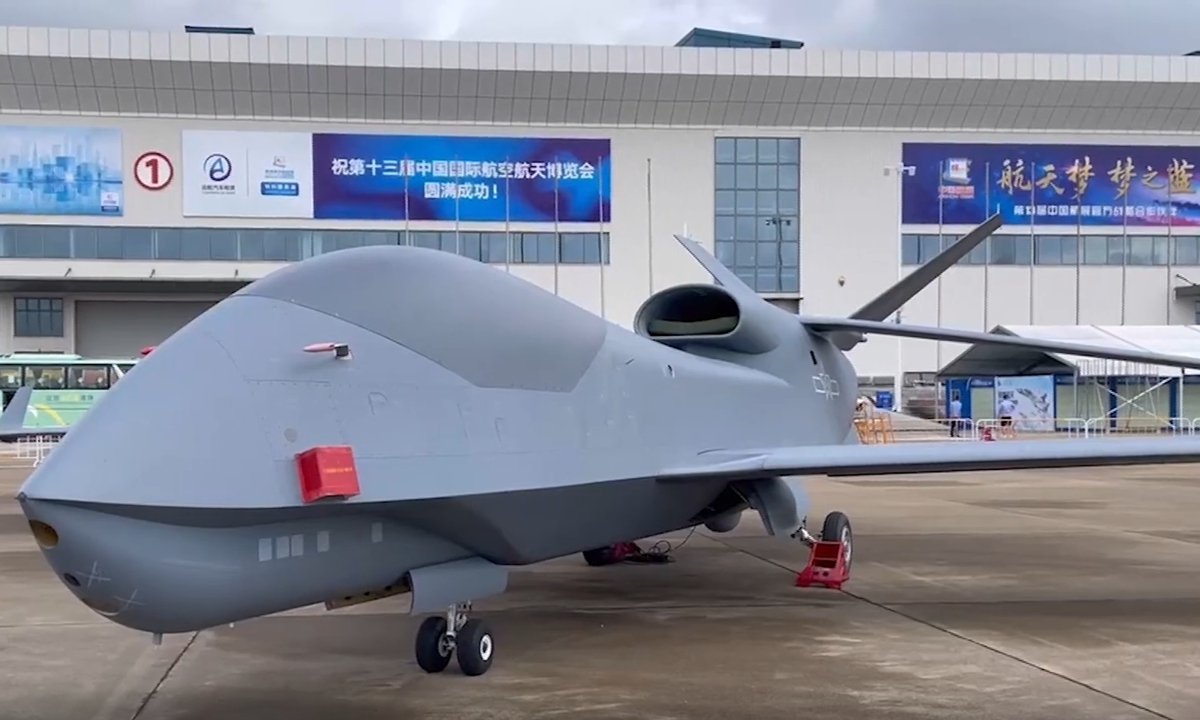Amid a protracted border standoff with India, the Chinese People’s Liberation Army Air Force (PLAAF) will, for the first time, display the WZ-7 ‘Soaring Dragon’ drone at the Zhuhai air show, to be held in south China’s Guangdong Province between September 28 and October 3.
- 7th-Gen Fighter Jet Or UFO: Netizens Spot A Mysterious Aircraft Being Towed Away To A Top-Secret Location In California
- India’s ‘White Elephant’: Why Is Indian Army Acquiring Bulky Arjun Tanks To Battle China In High-Altitude Ladakh?
- Why Is India Upgrading Its Air Force With Older MiG-29, Mirage 2000 Fighter Jets As It Looks To Battle China?
The high-altitude reconnaissance drone, considered China’s answer to the US’ Global Hawk, meets a similar role, particularly to scan the Western Pacific, Taiwanese and Japanese naval assets, and by extension reconnaissance missions at the Himalayan border with India.
The PLAAF’s pride and joy, J-20 ‘Mighty Dragon’, Y-20 large transport/strategic airlift aircraft (perceived as China’s response to the US’s C-17 Globemaster III and C-5 Galaxy), KJ-500 early warning aircraft, the H-6K bombers, and J-16D electronic warfare aircraft ‘drone’ too will be displayed and undertake flypasts, according to China Central Television (CCTV).
The WZ-7 Drone
Featuring a tandem/diamond-wing design, the large WZ-7 has a long-endurance, single jet engine, most likely believed to be the WS-10 that was earlier used to power the J-10s and J-20, AI-enabled networking and sensor fusion, highly encrypted jamming resistant data links to share battlefield information with fighting forces and ISR links with Chinese satellites.
This will give China unprecedented surveillance capabilities, in line with its ‘Intelligentized Warfare’, The EurAsian Times had reported. That the drone is being displayed in public means it has been inducted in service with PLAN and PLAAF units.
Why China’s PLA Navy Sidelined Its much-touted Z-10 Choppers For Russian Ka-52K Helicopters For Amphibious Ops?
The level of integration between assets can be gauged from the fact that one of the primary roles of the WZ-7 would be to also share targeting data with and possibly undertake guidance of the DF-21D Anti-Ship Ballistic Missile (ASBM), giving Chinese military commanders immense flexibility in executing Anti-Access/Area Denial (A2/AD) operations, in the event of loss of its forward assets like ships and aircraft in combat.

Experts believe that assets like the WZ-7 and the J-16D – a new type of electronic warfare aircraft – will be used in tandem, where surveillance information gathered by the WZ-7, will be shared with the J-16D.
The J-16D, which has large electronic warfare (EW) pods on both its wingtips, would accompany other aircraft in their missions and provide EW support like jamming, deception, and even signals intelligence (SIGINT) or intelligence-gathering by interception of signals.

The J-16D and WZ-7 have been tested in exercises and war games, in line with President Xi Jinping’s direction to the armed forces to “remain alert” and train in “realistic combat scenarios”.
India on the other hand does not have any fully operational and integrated drone system, except for the Heron series of drones used by the Indian Navy. The Nishant UAV is riddled with several problems while the Rustom series of drones are yet not operational.
India Awaiting US MQ-9 Drones
India is only just awaiting the 30 US-made MQ-9B Sky Guardian/Sea Guardian drones made by the General Atomics company, as a long-range high endurance strike platform. The Sea Guardian is to be used in the Indian Ocean Region (IOR), where its powerful radar can scan maritime regions, and can even be used to undertake Anti-Submarine Warfare (ASW).
As QUAD Transforms From Idea Into Action, There’s A Clear Message For ‘Iron Brothers’ China & Pakistan
With an endurance of over 40 hours, the Sea Guardian gives significant surveillance and reconnaissance capabilities to the Indian Navy – which has already been using two of the drones leased from General Atomics since November 2020.

However, this is assuming that China might challenge the Indian Navy and the Quad nations in the IOR, where it has a clear ‘away’ disadvantage, and cannot spare more than 2-3 ships at a time. Ten drones each are to be bought for the Indian Army, Navy, and Air Force.
Moreover, drones are yet to reach India since the $3 billion (Rs 22,000 crore) price tag for the armed drones has made India seek some more details from the US side, primarily regarding possible transfer-of-technology (ToT).
Did Pakistan / China’s JF-17 Thunder Beat Indian HAL Tejas To Win Argentine Fighter Jet Contract?
This can, however, be expected to be a far cry, since the deal is under the Foreign Military Sales (FMS) program of the US, where there is no joint manufacturing with local partners.
India’s Defence Acquisition Council (DAC) is yet to issue an Acceptance of Necessity (AoN), pending clarification on other things like whether maintenance facilities will be set up in India.
After an AoN, the MoD will issue an actionable Letter of Request (LoR) and after Washington’s response to that, a contract will be inked. Following a 15% downpayment, the rest of the installments will take place over a period of 5 to 6 years.
- Parth Satam is a Mumbai-based journalist who has been covering India’s defense sector for more than a decade. He maintains a keen interest in defense, aerospace and foreign affairs and can be reached at satamp@gmail.com
- Follow EurAsian Times on Google News




